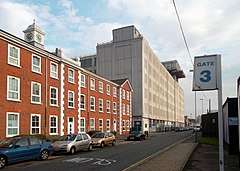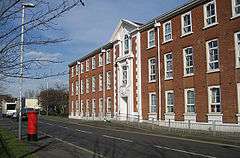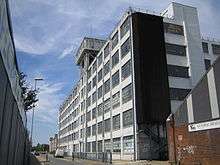Old Vinyl Factory
The Old Vinyl Factory is a complex of buildings formerly owned by the British music company EMI in Hayes, within the London Borough of Hillingdon. The site was originally purchased by the Gramophone and Typewriter Company and the buildings were designed by Wallis, Gilbert and Partners in the early 20th century.
| The Old Vinyl Factory | |
|---|---|
 View of the former headquarters (left) and Enterprise House on Blyth Road | |
 Location within the London Borough of Hillingdon  Old Vinyl Factory (Greater London) | |
| Former names | EMI Laboratories |
| Alternative names | EMI Buildings |
| General information | |
| Address | Blyth Road |
| Town or city | Hayes |
| Country | United Kingdom |
| Coordinates | 51.505278°N 0.425833°W |
| Groundbreaking | 9 February 1907 |
| Renovation cost | £250m (projected) |
| Design and construction | |
| Architecture firm | Wallis, Gilbert and Partners |
| Renovating team | |
| Renovating firm | U + I Group |
| Website | |
| The Old Vinyl Factory | |
While used by EMI, the site was responsible for the production of many well-known vinyl records by popular musicians of the 20th century, as well as radios and other broadcasting equipment.
In April 2011 the site was purchased for redevelopment by a joint venture of Cathedral Group PLC and Development Securities plc (now U + I Group). Under plans for £250 million of works, the site, covering 17 acres (6.9 ha),[1] is to include commercial and residential units and a university technical college.
History

The Gramophone and Typewriter Company, the precursor to EMI, purchased the site in the early 20th century and began constructing the first buildings in 1907. The company originally sold gramophones, and began making its own records in London in 1898[2] They were pressed at a factory in Germany until the Hayes Record Factory opened. From 1910, records bore the His Master's Voice label. The tenor Edward Lloyd took part in the groundbreaking ceremony.[3] Vinyl records were produced from 1952.[4]
What became the Cabinet Building was opened in 1911, after the Italian soprano Luisa Tetrazzini laid the cornerstone. The following year, a head office was built nearby on the site. During the First World War, the factory was used for the production of munitions.[3]
During the period 1927-29 the site was further extended with alterations and additions designed by Wallis, Gilbert and Partners (January 1927-cabinet department extensions; November 1927-record store; 1927-28-research laboratories, the administration building extension and the power house; November 1928-evaporating plant extension; May 1929-shipping department).[5] The site covered 58 acres (23 ha) by 1929 and 7,500 people were employed across it.[3]
The factories again returned to the production of munitions during the Second World War, as well as domestic radio receivers, which were marketed with some adaptations to households by the Home Office for £12. The site was bombed on 7 July 1944, killing 37 employees.[3]
In 1952, EMI began the production of "microgroove" records, made of vinyl rather than the shellac-based compound used for earlier records. Many major artists of the time - including The Beatles,[6] The Rolling Stones, Cliff Richard and Pink Floyd - had their vinyl records produced at the site.[7] Production reached its peak in the 1960s at the Hayes site, which covered 150 acres (61 ha) and saw 14,000 people in work there.[1]
In the 1970s, EMI moved its record-pressing operations to a different site, still within Hayes[3] and many of the buildings on the site moved over to defence electronics development and production.[8]
Redevelopment

The former head office building on the corner of Blyth Road/Trevor Road was acquired by Stonham Housing (part of Home Group) and converted to self contained flats in around 2000 and is not part of the main project site. This is also true of Enterprise House which was, for a while, run by Workspace although it has now changed hands (current owner unknown) and is (as of summer 2018) enclosed in scaffolding awaiting works.
The site was purchased in April 2011 by Purplexed, a joint venture between Cathedral Group PLC and Development Securities plc. The purchasers renamed the site "The Old Vinyl Factory" (from "London Gate Business Park"). The buildings on the site were renamed according to their former functions - one example being the "Shipping Building", which was where records were stored before being dispatched elsewhere. Purplexed stated the redevelopment would cost around £250 million to complete and that the company would give £40,000 to the London Borough of Hillingdon to cover the costs involved with putting the plan together.[9]
A seven-storey block of flats was announced as part of the development in February 2012. Its name, the Gatefold Building, was chosen as a wistful allusion to the gatefold sleeves of certain of EMI's vinyl record releases.[10] Planning permission for the building was granted in February 2012.[9]
The master plan for the entire site was approved by Hillingdon Council on 30 November 2012. It includes a new building, known as "The Picturehouse", which will house a Vue cinema. The site will also feature offices, 500 flats, a museum, restaurants, landscaped areas and playgrounds.[11]
By February 2015, Sonos, Host Europe Group and CHAMP Cargosystems had signed agreements to occupy the Shipping Building.[12]
The Global Academy secondary school opened in 2016 on the site originally planned as "The Picturehouse". The "Gatefold Building" is now also completed as of late 2016. As of March 2017 a new multi storey car park dubbed "The Music Box" is currently under construction at the west end of the site near Dawley Road/Bourne Bridge. Work is rapidly reaching completion at various points on site as of March 2017.
As of early May 2018, the Boiler House and the Machine Store buildings behind to the South, is almost complete and work has begun on the Pressing Plant to Boiler House's East which is the new chosen location of the cinema which will see a first in Hayes for the first time in around 50 years.
At the east end of the site and not officially part of the project are Paradigm Housing's 'The Stylus' on the former Damont Audio plot, as well as Bellway's 'Bluenote' which is the former Electropatent plot. Both of these projects are well underway as of summer 2019 and will be of similar function to the rest of the redevelopment area with commercial units at ground level with residential above.
As at autumn 2019, work is underway at the Powerhouse to create a innovation hub. Also, planning permission has been secured for 1 Vinyl Square on the plot West of the Global Academy with work to commence soon, and permission is being sought for the Assembly Buildings completion which was briefly the car park behind Global Academy. The Material Store complex (West of Gatefold) is well underway with The Pressing Plant cinema to commence after completion . Status from East to West as at November 2019...
The Stylus-Final fitting out, Bluenote-Underway, Gatefold-Complete, Material Store-Underway, Pressing Plant-To follow Material Store, Machine Store-Complete, Boiler House-Complete, Power House-Underway, Assembly Buildings-Awaiting permission, Global Academy-Complete, Record Store-Complete, Cabinet Building-Awaiting commencement, One Vinyl Square-Work to start imminently, Shipping Building-Complete, Music Box-Complete, Veneer Building Car Park-Awaiting permission.
References
- "The Old Vinyl Factory". Cathedral Group PLC. Retrieved 15 March 2012.
- For the Record, No 32, pp434-5.
- "History of the Old Vinyl Factory". The Old Vinyl Factory. Retrieved 15 March 2012.
- Peter Martland, EMI Since Records Began, Batsford, 1997
- Skinner, Joan (1997). Form and Fancy: Factories and Factory Buildings by Wallis, Gilbert & Partners, 1916-1939. Liverpool University Press. ISBN 0853236224.
- "Hayes FM brings music and culture to town centre festival". Hillingdon & Uxbridge Times. 10 September 2010. Retrieved 18 March 2012.
- Griffith, Jack (17 February 2010). "Happily riding the wave of vinyl retro chic". Uxbridge Gazette. Retrieved 18 March 2012.
- Martin, Derek (1986). Thorn EMI: 50 Years of Radar : 50 Years of Company Involvement with Radar Technology 1936-1986. Thorn EMI Electronics, Radar Division. ISBN 9780951213100.
- Griffith, Jack (22 February 2012). "Multi-million EMI revamp one step closer". Uxbridge Gazette. Retrieved 15 March 2012.
- Griffiths, Jack (8 February 2012). "'Gatefold Building' housing scheme on EMI site". Uxbridge Gazette. Retrieved 15 March 2012.
- Griffith, Jack (30 November 2012). "The Old Vinyl Factory planning consent 'historic for Hayes'". Uxbridge Gazette. Retrieved 3 December 2012.
- Ackermann, Will (11 February 2015). "Firms sign up to move into Old Vinyl Factory in Hayes". Uxbridge Gazette. Retrieved 28 February 2016.
External links
| Wikimedia Commons has media related to EMI buildings, Hayes. |